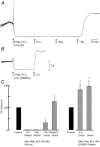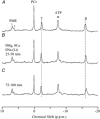Mechanisms for monovalent cation-dependent depletion of intracellular Mg2+:Na(+)-independent Mg2+ pathways in guinea-pig smooth muscle
- PMID: 12844514
- PMCID: PMC2343295
- DOI: 10.1113/jphysiol.2003.047795
Mechanisms for monovalent cation-dependent depletion of intracellular Mg2+:Na(+)-independent Mg2+ pathways in guinea-pig smooth muscle
Abstract
It has been suggested that magnesium deficiency is correlated with many diseases. 31P NMR experiments were carried out in order to investigate the effects of Na+ substitution on Mg2+ depletion in smooth muscle under divalent cation-free conditions. In the taenia of guinea-pig caeci, the intracellular free Mg2+ concentration ([Mg2+]i) was estimated from the chemical shifts of (1) the beta-ATP peak alone and (2) beta- and gamma-ATP peaks. Both estimations indicated that [Mg2+]i decreased only very slowly in Mg(2+)-free, Ca(2+)-free solutions in which Na+ was substituted with large cations such as NMDG (N-methyl-D-glucamine) and choline. Furthermore, the measurements of tension development supported the suggestion of preservation of intracellular Mg2+ with NMDG substitution. Substituting extracellular Na+ with the small cation, Li+, also shifted the beta-ATP peak towards a lower frequency, but the frequency shift was significantly less than that seen upon Na+ substitution with K+. The estimated [Mg2+]i depletion was, however, comparable with that seen after Na+ substitution with K+ using the titration curves of metal-free and Mg(2+)-bound ATP obtained in Li(+)-based model solutions. It was concluded that Mg2+ rapidly decreases only when small cations were the major electrolyte of the extracellular medium. Na+ substitutions with NMDG, choline or Li+ had little effect on intracellular ATP concentration after 100 min treatment.
Figures





References
-
- Bock JL, Wenz B, Gupta RK. Changes in intracellular Mg adenosine triphosphate and ionized Mg2+ during blood storage: detection by 31P nuclear magnetic resonance. Blood. 1985;65:1526–1530. - PubMed
-
- Braun FJ, Broad LM, Armstrong DL, Putney JW., Jr Stable activation of single CRAC-channels in divalent cation-free solutions. J Biol Chem. 2000;276:1063–1070. - PubMed
-
- Dillon PF. 31P Nuclear magnetic resonance spectroscopy. In: Bárány M, editor. Biochemistry of Smooth Muscle Contraction. San Diego USA: Blackwell Science Inc; 1996. pp. 393–404.
-
- Ebel H, Günther T. Role of magnesium in cardiac disease. J Clin Chem Clin Biochem. 1983;21:249–265. - PubMed
Publication types
MeSH terms
Substances
Grants and funding
LinkOut - more resources
Full Text Sources
Miscellaneous

